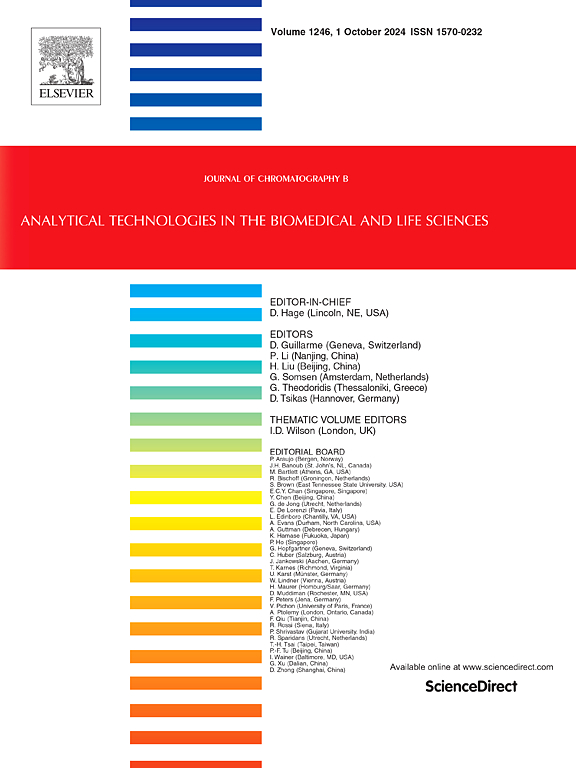In vivo sequential metabolism by UPLC/MS, network pharmacology and cell experimentation for screening Q-markers of Penthorum chinense Pursh
IF 2.8
3区 医学
Q2 BIOCHEMICAL RESEARCH METHODS
引用次数: 0
Abstract
PCP (Penthorum chinense Pursh) is a traditional Chinese medicine of Miao nationality, and is used to prevent and treat liver diseases. Modern research shows that it has anti-hepatitis virus, anti-hepatic fibrosis and anti-oxidation effects. It has certain curative effect on cholestatic liver injury (CLI). However, the quality marker (Q-marker) of PCP in the treatment of CLI is still unclear. This study aims to explore and screen the Q-markers of PCP using a novel multi-dimensional strategy of in vivo sequential metabolism, network pharmacology and cell experimentation. Sequential metabolism in rats identified 18 prototypes and 123 metabolites, primarily flavonoids, with hydroxylation, reduction, acetylation, and glucuronidation as the main metabolic pathways. A total of 23 inherent components of PCP were identified, including 18 prototype components exposed in blood and 5 prototypes inferred from reverse tracing of their metabolites. Network pharmacology analysis revealed six potential Q-markers for the treatment of CLI: pinocembrin, apigenin, alpinetin, naringenin, pinocembrin-7-O-β-D-glucoside, and 5-methoxy pinocembroside. The core therapeutic targets were identified as TNF, AKT1, and ESR1. Molecular docking analysis demonstrated that all the six potential Q-markers exhibited binding energies below −6.5 kcal/mol with targets, suggesting their significant role in CLI treatment. Cell experiments indicated that six Q-markers had certain pharmacological activity against CLI. Furthermore, quantification of six Q-markers demonstrated that their content remained relatively stable across 12 batches of Gansu Granules. These findings provide a material basis for the quality control and development of PCP.
采用超高效液相色谱/质谱联用、网络药理学及细胞实验筛选五味子q -标记物
PCP (Penthorum chinense Pursh)是苗族的传统中药,用于预防和治疗肝脏疾病。现代研究表明,它具有抗肝炎病毒、抗肝纤维化和抗氧化作用。对胆汁淤积性肝损伤(CLI)有一定的疗效。然而,PCP治疗CLI的质量标志(Q-marker)尚不明确。本研究旨在通过体内序列代谢、网络药理学和细胞实验等多维策略,探索和筛选PCP的q标记物。大鼠序列代谢鉴定出18个原型和123种代谢物,主要是类黄酮,羟基化、还原、乙酰化和葡萄糖醛酸化是主要的代谢途径。共鉴定出23种PCP固有成分,包括18种暴露于血液中的原型成分和5种通过其代谢物反向追踪推断的原型成分。网络药理学分析发现6种可能用于治疗CLI的q -marker: pinocenin, apigenin, alpinetin,柚皮素,pinocenin -7- o -β-D-glucoside,和5-甲氧基pinocomside。核心治疗靶点被确定为TNF、AKT1和ESR1。分子对接分析表明,6种潜在q标记与靶标的结合能均低于- 6.5 kcal/mol,表明它们在CLI治疗中具有重要作用。细胞实验表明6种q标记物对CLI具有一定的药理活性。此外,6种q标记的定量分析表明,它们在12批甘肃颗粒中的含量保持相对稳定。这些发现为PCP的质量控制和开发提供了物质依据。
本文章由计算机程序翻译,如有差异,请以英文原文为准。
求助全文
约1分钟内获得全文
求助全文
来源期刊

Journal of Chromatography B
医学-分析化学
CiteScore
5.60
自引率
3.30%
发文量
306
审稿时长
44 days
期刊介绍:
The Journal of Chromatography B publishes papers on developments in separation science relevant to biology and biomedical research including both fundamental advances and applications. Analytical techniques which may be considered include the various facets of chromatography, electrophoresis and related methods, affinity and immunoaffinity-based methodologies, hyphenated and other multi-dimensional techniques, and microanalytical approaches. The journal also considers articles reporting developments in sample preparation, detection techniques including mass spectrometry, and data handling and analysis.
Developments related to preparative separations for the isolation and purification of components of biological systems may be published, including chromatographic and electrophoretic methods, affinity separations, field flow fractionation and other preparative approaches.
Applications to the analysis of biological systems and samples will be considered when the analytical science contains a significant element of novelty, e.g. a new approach to the separation of a compound, novel combination of analytical techniques, or significantly improved analytical performance.
 求助内容:
求助内容: 应助结果提醒方式:
应助结果提醒方式:


